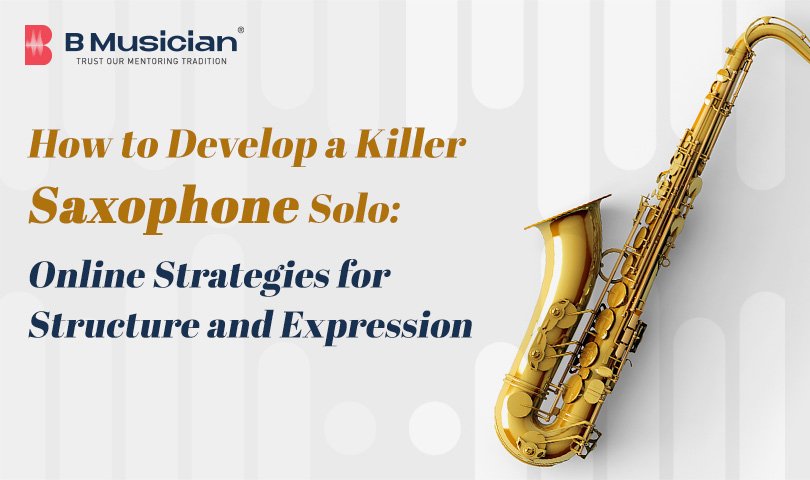Prelude:
There’s nothing quite like a killer saxophone solo — one that cuts through the noise, captivates the crowd, and speaks volumes without saying a word. Whether it’s a smoky jazz bar, a pulsating rock gig, or a soulful R&B ballad, the saxophone remains one of the most expressive instruments in modern music. But here’s the kicker — developing a solo that truly kills doesn’t happen by chance. It’s a blend of craft, intuition, and structure.
Thanks to technology, today’s musicians don’t need to rely solely on in-person mentorships or classroom settings to sharpen their skills. With the rise of online saxophone lessons, developing a world-class solo has become more accessible, flexible, and deeply personal than ever before.
In this blog, we’ll dive into strategies you can use to craft a solo that doesn’t just sound good — but leaves an imprint. We’ll explore how to balance technique with emotion, how to structure a solo that tells a story, and how to leverage online resources to become the soloist you aspire to be.
Understanding the Foundation: What Makes a Saxophone Solo “Killer”?
Before diving into advanced strategies, let’s take a moment to break down what truly makes a saxophone solo unforgettable.
A great solo isn’t about speed or high notes. It’s about storytelling. The best saxophonists from Charlie Parker to Kenny Garrett — know how to create tension, resolution, and emotion through phrasing, rhythm, dynamics, and articulation.
Here’s what you’ll often find in the best solos:
- A clear beginning, middle, and end (narrative structure)
- Memorable motifs that evolve over time
- Emotional expression that connects with the audience
- Controlled technique that supports, not overshadows, the musical story
In many online saxophone lessons, you’ll find educators emphasising these musical pillars because flash without foundation is just noise.
Structuring Your Solo: From Chaos to Cohesion
Improvisation doesn’t mean random. A well-structured solo feels organic, but it often follows a clear design. Whether you’re soloing over a jazz standard, pop ballad, or funk groove, a strong structure is essential.
Here’s a powerful framework to start with:
1.The Intro (Set the Scene)
Start simply. A strong opening might include a motif or riff that grabs attention. Think of it as the first line of a novel — it sets the tone.
2. The Build (Add Complexity)
Once you’ve introduced a theme, develop it. Use variations, rhythmic shifts, or dynamic changes. This is where tension grows. Consider using techniques like call-and-response, ascending lines, or metric modulation to build energy.
3. The Climax (Let It Soar)
This is the peak of your story. Use your most emotionally charged phrases here. Don’t just play louder or faster — think expressively. Grow the dynamics and energy without losing control
4. The Resolution (Bring It Home)
Wind things down artfully. Reintroduce your original motif or paraphrase it. Leave space. Let the music breathe as you close the arc.
Many seasoned educators offering online saxophone lessons teach solo structure using backing tracks, breakdowns of great solos, and real-time feedback — helping you shape raw ideas into powerful narratives.
Expressive Tools: The Language of Emotion
Technique is the foundation, but expression is the soul of a killer solo. Luckily, expression can be taught, practiced, and refined — especially through high-quality online saxophone lessons that focus on nuance.
Here are some vital tools to elevate your expression:
1.Dynamics
Use volume creatively. A whispering soft phrase can sometimes hit harder than a roaring scream. Practice crescendos, decrescendos, and sudden changes to keep listeners engaged.
2.Articulation
Tonguing, slurring, and staccato all change the character of your lines. Mix up your articulation to bring variety and clarity to your phrasing.
3.Tone VariationsThe saxophone is one of the few instruments that allows players to shape their tone in limitless ways. Experiment with airy vs. brassy tones, and explore vibrato, growl, or sub- tones for added emotion.
4.Phrasing and Space
Miles Davis famously said, “It’s not the notes you play, it’s the notes you don’t play.” Leave room for your audience to feel. Don’t be afraid of silence or subtlety.
Many online saxophone lessons include exercises focused purely on expression — like practicing one phrase in ten different emotional styles, or mimicking vocal inflections using the horn.
Using Technology to Supercharge Your Solos
Today’s digital age has completely revolutionised how musicians learn and create. You no longer need to rely solely on jam sessions or in-person teachers to grow as a soloist.
Here’s how you can use online tools to your advantage:
A. lay-Along Tracks
Platforms like iReal Pro, YouTube backing tracks, or even AI-generated accompaniments allow you to practice your soloing over real progressions, tempos, and grooves. You can loop sections, change keys, or slow down parts to focus on tricky transitions.
B. Transcription Tools
Apps like Transcribe! or Sound -slice help you slow down solos of your favourite saxophonists so you can dissect phrasing, articulation, and technique. Many online saxophone lessons also include solo breakdowns with annotated transcriptions.
C. Loop Stations and DAWs
Want to build a solo from scratch? Use a loop station or DAW (Digital Audio Workstation) to layer rhythms, chords, and melodies. This is a fun and hands-on way to experiment with structure and texture.
D. Virtual Lessons and Masterclasses
Accessing global mentors is easier than ever. With online saxophone lessons, you can study jazz in New York, funk in LA, or classical technique from Europe — all from your home.
Many platforms now offer 1-on-1 coaching, video feedback, and interactive group classes, so you’re never stuck learning alone.
The Mindset of a Soloist: Confidence, Curiosity, and Consistency
Finally, let’s talk about mindset — the often overlooked, yet most powerful tool in your soloing arsenal.
Confidence
Believe in your voice. A killer solo doesn’t have to be perfect — it has to be you. Commit to your ideas, even if they’re simple. The most confident solos often have the fewest notes, played with absolute conviction.
Curiosity
Stay inspired. Listen to different genres. Transcribe solos from unexpected sources — maybe a blues guitar line or a Bollywood flute riff. Let your curiosity lead your musical vocabulary.
Consistency
Expression and technique don’t grow overnight. Set regular, intentional practice goals. Many Carnatic saxophone lessons offer structured learning paths with milestones that help you stay consistent and motivated.
Conclusion:
At its core, a killer saxophone solo isn’t about mimicking Coltrane or trying to outplay your peers — it’s about discovering and expressing your voice. The solo is your moment to speak, to connect, and to move people in a way only you can.
And the beautiful truth? You don’t need to go it alone. With access to high-quality online saxophone lessons, a supportive global community, and endless digital tools, you have everything you need to unlock your full potential.
So plug in, press record, and start building solos that don’t just play notes — but tell unforgettable stories.
























